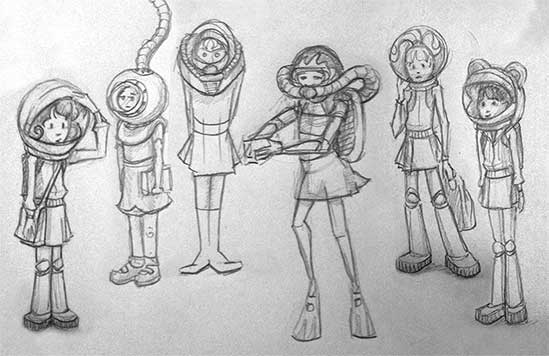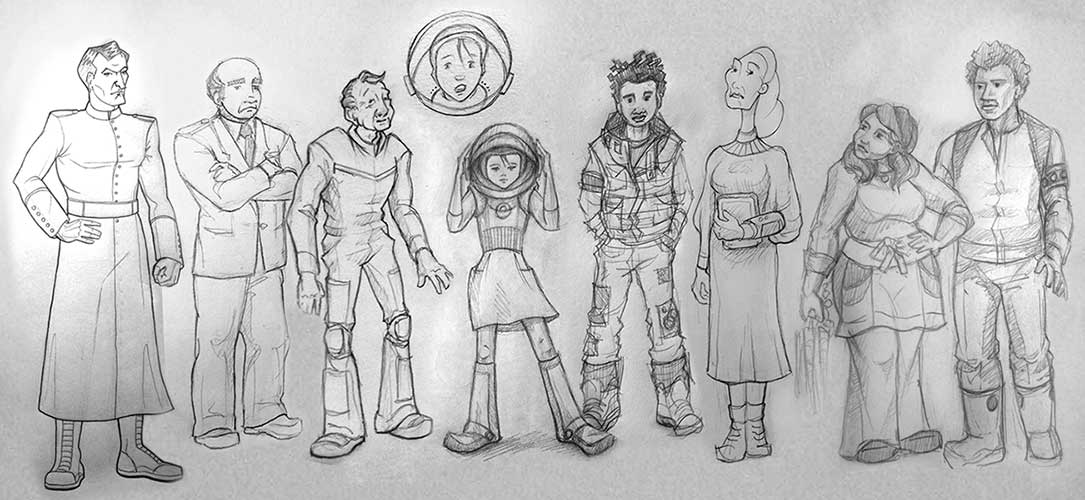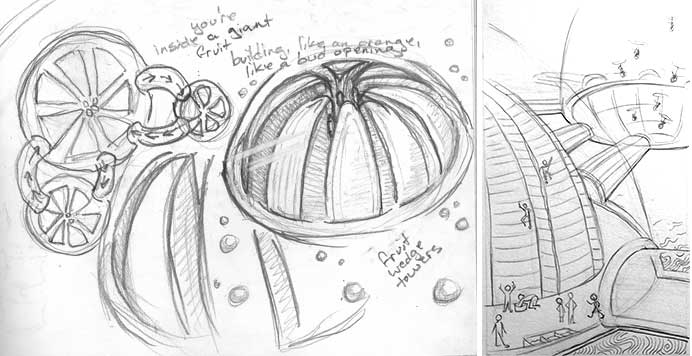With immense respect for comic book artists, it’s fair to say I was a little intimidated by the thought of making my own comic book. It’s a huge undertaking! The process of making a comic book is like putting together a giant puzzle, one which stretches your creative muscles in limitless ways. So when Vanessa and I decided to make COURI VINE as a comic book I knew it was not something to attempt lightly. For popular comic books, it might take five artists to complete one book. This includes a concept artist, penciller, inker, colorist, and letterer. Here, I was about to attempt all of these roles. But I listen to my mother’s words of wisdom, “take one thing at a time,” grabbed my sketchbook, and started chipping away.
Vanessa and I started with the idea of a girl with an unbeknownst superpower who lives in Moon City with her senile grandfather, an old scientist who was displaced from Earth years ago. From there I set out to determine what this world looks like. At this point in the process, my role as artist was to develop concept art for the characters, determine the setting, architectural designs, spaceship and robot designs, and develop a map of the city.

Life drawing had been something I practiced on a fairly regular bases. But drawing a model who is posing for you and doing portraits is much different than drawing for comics. In my research, I picked up Tom Bancroft’s book “Characters Mentor,” and also “How To Draw The Marvel Way” by Stan Lee and have referred to these books often. With comics, characters emote with their entire bodies. Expression is found not only in the face but also in the pose of a character. Even the perspective of the composition can bring a character to life. I continue to learn and practice this as I illustrate these characters in each panel.
Then there’s the setting for the characters. When it comes to designing a futuristic, sustainable world, I’m intrigued by Janine Benyus’ concept of biomimicry and her book called “Biomimicry: Innovation Inspired by Nature.” According to Wikipedia, biomimicry is the imitation of the models, systems, and elements of nature for the purpose of solving complex human problems. How cool is that!? I wanted my designs to reflect this idea.
Other inspiration was found at an instillation by Architects of Art called the “Luminarium Pentalum.” These giant inflated structures linked domes to a maze of tunnels and allowed sunshine to stream in through colorful vinyl panels creating brilliant arrays of light. Inflated structures on the moon connecting existing lava tunnels, it made sense!
Vanessa and I also had questions like: What kind of games do people play in Moon City? How would people get around? Where would they live? What were the dilemmas and advantages of having a lower gravitational pull? How many hours are in a day in Moon City? All of these questions, and more, needed to be considered when approaching the design.
Helicopter Cycles were a must! Take an old-timey, penny-farthing bike crossed with a helicopter, add a lower gravitational pull, and there you have it, a fun and potentially life threatening, pedal-driven, aeronautic machine specially designed for lunar extreme sports!
Book 1 of COURI VINE scratches the surface of the possibilities in Moon City, exploring ideas of sustainable living in a man-made province, concepts that will continue to unfold in the upcoming books. Included here are some of the pre-visuals developed for the first book.
Like Couri, I am discovering what the universe has to offer, and what I have to offer in return. Thanks for reading.



